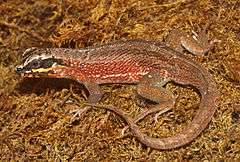Iguania
The Iguania are a suborder of the Squamata (snakes and lizards) that contains the iguanas, chameleons, agamids, and New World lizards, such as anoles and phrynosomatids. Using morphological features as a guide to evolutionary relationships, the Iguania are believed to form the sister group to the remainder of the Squamata. However, molecular information has placed Iguania well within the Squamata as sister taxa to the Anguimorpha and closely related to snakes.[1] Iguanians are largely arboreal and have primitively fleshy, nonprehensile tongues, although the condition is highly modified in chameleons. The group has a fossil record that extends back to the Early Jurassic (the oldest known member is Bharatagama, which lived about 190 million years ago in what is now India),[2] and currently includes these extant families:[3]
- Family Agamidae – agamid lizards, Old World arboreal lizards
- Family Chamaeleonidae – chameleons
- Family Iguanidae – American arboreal lizards, chuckwallas, iguanas
- Subfamily Corytophaninae – helmet lizards
- Subfamily Crotaphytinae – collared lizards, leopard lizards
- Subfamily Hoplocercinae – dwarf and spinytail iguanas
- Subfamily Iguaninae – marine, Fijian, Galapagos land, spinytail, rock, desert, green, and chuckwalla iguanas
- Subfamily Phrynosomatinae – North American spiny lizards
- Subfamily Polychrotinae – anoles and kin
- subclade of Polychrotinae Anolis: anoles
- subclade of Polychrotinae Polychrus
- subclade of Polychrotinae Leiosaurini: leiosaurs
- subclade of Leiosaurini Leiosaurae:
- subclade of Leiosaurini Anisolepae:
- Subfamily Tropidurinae – tropidurine lizards
- subclade of Tropidurinae Leiocephalus: curly-tailed lizards
- subclade of Tropidurinae Liolaemini: South American swifts
- subclade of Tropidurinae Tropidurini: neotropical ground lizards
- family Opluridae – Malagasy iguanas
Phylogeny
Below is a cladogram from the phylogenetic analysis of Daza et al. (2012) (a morphological analysis), showing the interrelationships of extinct and living iguanians:[4]
References
- ↑ http://www.cnah.org/pdf_files/518.pdf
- ↑ Evans, Susan E.; Prasad, G. V. R.; Manhas, B. K. (2002). "Fossil lizards from the Jurassic Kota Formation of India". Journal of Vertebrate Paleontology. 22 (2): 299. doi:10.1671/0272-4634(2002)022[0299:FLFTJK]2.0.CO;2.
- ↑ Schulte II, J. A., J. P. Valladares, and A. Larson. (2003) [Phylogenetic relationships within Iguanidae inferred using molecular and morphological data and a phylogenetic taxonomy of iguanian lizards.] Herpetologica 59: 399-419
- ↑ Daza, J. D.; Abdala, V.; Arias, J. S.; García-López, D.; Ortiz, P. (2012). "Cladistic Analysis of Iguania and a Fossil Lizard from the Late Pliocene of Northwestern Argentina". Journal of Herpetology. 46: 104. doi:10.1670/10-112.
 |
Wikimedia Commons has media related to Iguania. |
